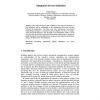Free Online Productivity Tools
i2Speak
i2Symbol
i2OCR
iTex2Img
iWeb2Print
iWeb2Shot
i2Type
iPdf2Split
iPdf2Merge
i2Bopomofo
i2Arabic
i2Style
i2Image
i2PDF
iLatex2Rtf
Sci2ools
COST
2010
Springer
2010
Springer
Adaptation in Turn-Initiations
This study investigates the variability in the temporal alignment of turn initiations and its relationship to the entrainment and power structure between the interlocutors. The data come from spontaneous, task-oriented human-human dialogues in Standard American English, and focus on singleword turn-initial utterances. The descriptive and quantitative analysis of the data show that an emergent asymmetrical dominance relationship is constructed partly through the accommodation (or its absence) to the temporal and rhythmic features of interlocutors' turn-initiations.
COST 2010 | Emergent Asymmetrical Dominance | Multimedia | Singleword Turn-initial Utterances | Task-oriented Human-human Dialogues |
| Added | 14 May 2011 |
| Updated | 14 May 2011 |
| Type | Journal |
| Year | 2010 |
| Where | COST |
| Authors | Stefan Benus |
Comments (0)

